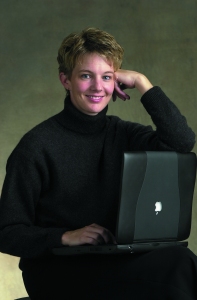
VOL.10 NO. 2 THE MAGAZINE OF THE UNIVERSITY OF UTAH FALL 2000
UP FRONT
To Wonder, and Wander
BY THERESA DESMOND, EDITOR
 |
In one of my favorite essays,
"The Loss of the Creature," Walker Percy notes that "the
biography of scientists and poets is usually the story of the discovery
of the indirect approach, the circumvention of the educator's presentation….[I]nstead
of being a consumer of a prepared experience, I am a sovereign wayfarer,
a wanderer…." I was reminded of Percy when I came across a writer
in the June issue of that higher-education staple, Gourmet magazine,
who said of a culinary historian that "the difference between scholars
and ordinary people—one difference at least—is that scholars
take wondering as a course of action."
Wandering and wondering—perhaps I'm drawn to writers who encourage the "indirect approach" as an antidote to the day planners, Palm Pilots, and cell phones that ask us to measure out our days in increments and account for our time and whereabouts with exactitude. In an age that, as CBS newsman Bob Schieffer reminded recent U graduates, demands immediate, perfect results, it's well to remember the value of long-term, long-view consideration, of a little meandering.
A university, home of some
of the scientists and poets to which Percy refers, has traditionally been
a place that encourages a rich sense of wondering about what to learn,
how to learn, how to do things differently, how to see the world anew.
Those questions are best provoked by individuals who want to follow an
idea or theory, not a script or recipe. Such exploration is not simply
intellectually stimulating for those who do that asking; their findings
generate thought, change, and improvement for the larger worlds of which
they are a part.
Wondering is also, at least
in some form, wandering. Those who consider often don't stop to
consider; they travel, physically and mentally, and sometimes without
a set destination. Sheer movement can be an unexpected catalyst, whether
that movement is a conversation, a long drive, or a turn to discover a
new view. Our indirection is our direction.
Of course, there will always
be a cry for accountability, for checks and balances—a legislator
will want to know how many hours a faculty member spends in the classroom,
a parent or student will want to know how tuition is being spent, an investor
will want to see a return, a publisher will wonder if a manuscript will
ever be finished. Framed and timed correctly, those things, too, keep
a university in touch with its communities. Wondering without, eventually,
a recognition of our connectedness and communal responsibility empties
a university of its vibrancy.
Part of Continuum's
role is to take readers along on these wondering and wandering journeys.
For 10 years, the magazine has served as one connection between the U
and its communities: faculty, staff, alumni, and friends. Though one could
reflect on all the changes that decade has wrought, it's perhaps more
relevant to reflect on what has been constant—the sense of wonder
that the members of the University's communities bring to the institution.
The stories of their inquisitiveness remind us why "lifelong learning"
is not simply a University program but a fundamental part of who and why
we are.
In this issue, we're able
to tell a few of those stories. Writer Mary Dickson, who last wondered
in these pages what would happen to a community that loses its local businesses,
e.g., The Waking Owl bookstore, writes about Professor Jim Svendsen, who,
30 years ago, wondered why no one performed Greek theater, and has been
producing the Classical Greek Theatre Festival ever since. Anne Peterson,
the former editor of Continuum, tells about students who wander
off to Washington, D.C., for internships sponsored by the Hinckley Institute
of Politics, and just how significant one semester's immersion in politics
can be. Charles Dibble, a wonderer emeritus, wandered into The Florentine
Codex and uncovered almost everything we know about Aztec culture,
as writer Elise Lazar tells us.
In a literal case of wondering
and wandering, Ann Floor introduces Utah Museum of Natural History paleontologist
Scott Sampson, who searches the world for dinosaur remains, and takes
us along for a dinosaur dig in the central part of Utah.
And what about computer science
graduates who have wandered into a very potent moment in time for the
computer industry? Continuum intern Kathryn Austin explains how
the rapid-fire rate of questioning and innovation in that industry is
affecting both the University and its graduates, and alumnus Andy Cooley
puts a finer point on the subject in his "And Finally…"
essay.
The best stories are not monologues but dialogues, which is to say that without reader feedback and suggestions, the stories in this magazine are only half-told. So, "instead of being a consumer of a prepared experience," let us know what you've been wondering: continuum@alumni.utah.edu.
Continuum Home Page - University of Utah Home Page - Alumni Association Home Page
Questions, Comments - Table of Contents
Copyright 2000 by The University of Utah Alumni Association